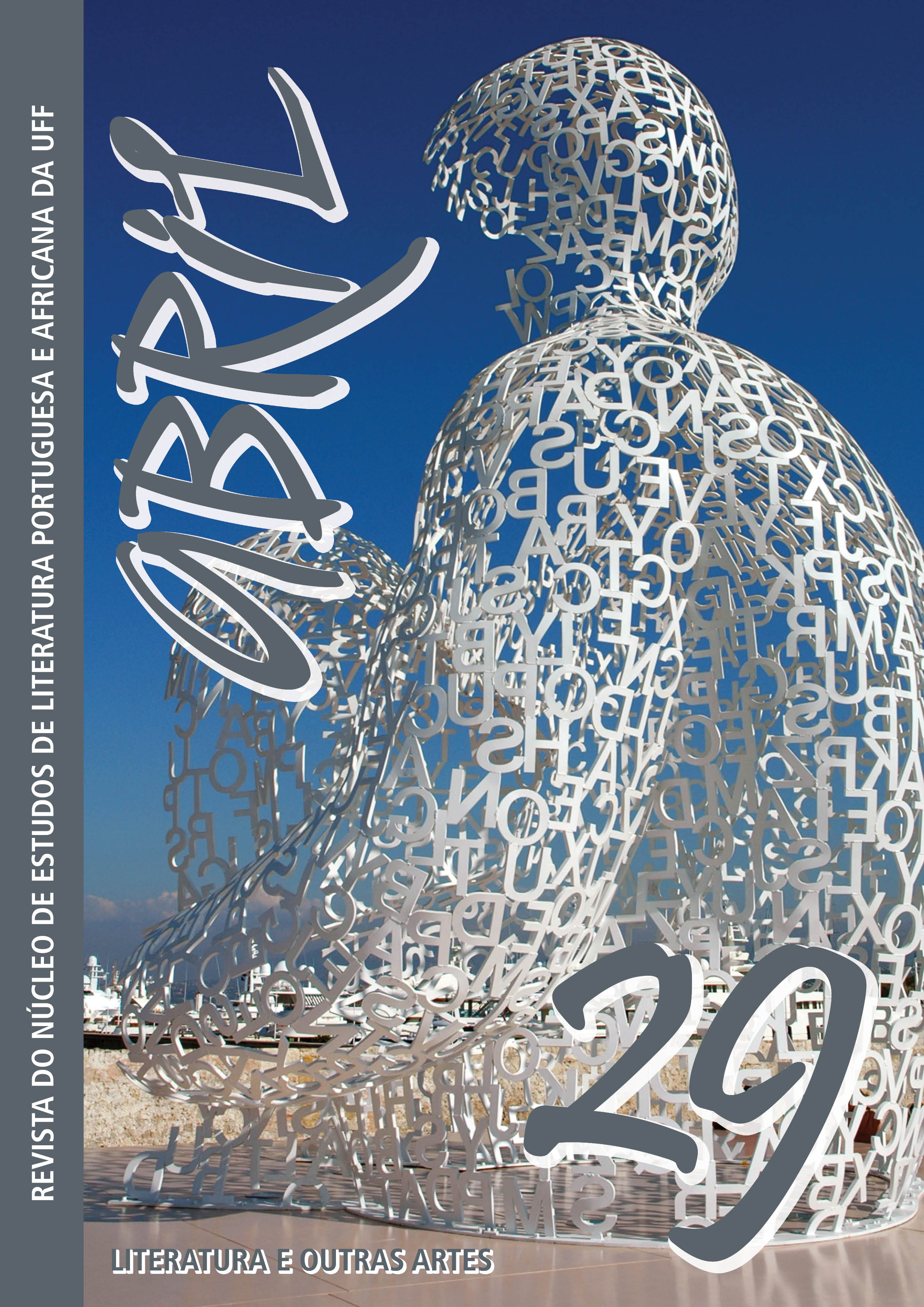Cidade sem nome, homem sem face: escolhas e estratégias na adaptação fílmica de O homem duplicado
DOI:
https://doi.org/10.22409/abriluff.v14i29.54724Palavras-chave:
O homem duplicado, Enemy, Adaptação, RemidiaçãoResumo
Ao chegar aos cinemas em 2013, Enemy, filme hispano-canadense dirigido por Denis Villeneuve que adapta o romance O homem duplicado (2002), do escritor português José Samarago, dividiu radicalmente crítica e público. O caráter experimental, soturno e psicológico de Enemy também colocou em xeque sua própria fidelidade ao texto fonte de Saramago, que, como é de conhecimento comum, também é afeito às experimentações na prosa. Em face das potencialidades inovantes e arrojadas do filme e do romance, cada um em seu próprio território e com seus próprios artifícios, o que propomos nesse artigo é um estudo, pelo viés das Teorias da Adaptação, sobre as estratégias adaptativas empregadas no processo de remidiação (BOLTER; GRUSIN, 2000) d’O homem duplicado de Saramago para a linguagem cinematográfica. Para tanto, pretendemos realizar uma leitura imanente pautada nos aspectos formais e temáticos das duas obras: alterações e permanências de elementos narrativos e imagéticos; rupturas e continuidades formais, simbólicas e temáticas, além das escolhas e recursos da linguagem cinematográfica empregados pelos adaptadores em Enemy, bem como suas (possíveis) motivações. O escopo da nossa análise está voltado sobretudo para dois elementos insólitos do romance que foram mantidos por Villeneuve durante o processo de tradução intersemiótica (PLAZA, 2003): a cidade moderna como espaço inquietante, sufocante e labiríntico que apequena os indivíduos e retira-lhes a identidade; e o arquétipo cultural, literário e psicanalítico (RANK, 2013) do duplo.
Downloads
Referências
BARTHES, R. A morte do autor: imagem, música, texto em O rumor da língua. São Paulo: Martins Fontes, 2004
BAVILLE. The Making of Enemy (2013), 2015. (17min23s). Disponível em: https://youtu.be/ztl5THrzx-4 Acesso em: 12 set. 2020.
BOLTER, J.D.; GRUSIN, R. Remediation: understanding new media. Cambridge: The MIT Press, 2000.
BRADSHAW, P. Enemy review: a Thrilling Take on the Doppelganger Theme. The Guardian. Londres, 1 jan. 2014.
CURZON. Enemy interview with Denis Villeneuve, 2014. (02min53s). Disponível em: https://youtu.be/2x-HaRcs2xQ Acesso em: 12 set. 2020.
ENEMY. Direção: Denis Villeneuve. Roteiro: Javier Gullón. Produção: M. A. Faura e Niv Fichman. Madrid: Mecanismo Films, 2013. 90 min. ‘ENSAIO sobre a cegueira’ é deprimente, diz ‘Times’. BBC Brasil. 15 mai. 2008. Disponível em: www.bbc.com/portuguese/reporterbbc/story/2008/05/080515_pressblindness_ba Acesso em 13 set. 2020.
HINDS, S. Allusion and intertext: dynamics of appropriation in roman poetry. Cambridge: Cambridge University Press, 1998.
HORNADAY, A. ‘Enemy’ movie review. The Washington Post. Washington, 20 mar. 2014.
HUTCHEON, L. Uma teoria da adaptação. Trad. André Cechinel. 2. ed. Florianópolis: Editora UFSC, 2013.
INCENDIES. Direção: Denis Villeneuve. Roteiro: Denis Villeneuve e Valérie Beaugrand-Champagne. Produção: Luc Déry e Kim McCraw. Montreal: Microscope, 2010. 130 min.
KRISTEVA, J. Introdução à semanálise. Tradução de Lúcia Helena França Ferraz. 2 ed. São Paulo: Perspectiva, 2005.
LIRA, B.; MAGALHÃES, D. Do Homem Duplicado a Enemy: adaptação e reinvenção do duplo no cinema. Revista Culturas Midiáticas, Ano X, n. 18 jan-jul/2017.
MACEDO, A.B. Enemy e O homem duplicado: solidão, narcisismo, massificação. Revista Eletrônica Falas Breves, vol. 05. Universidade Federal do Pará, Campus Universitário do Marajó-Breves. Maio/junho de 2018.
MACIEL, M.E. Para além da adaptação: formas alternativas de articulação entre literatura e cinema. In: NASCIMENTO, Eduardo et al. (orgs.). Literatura em Perspectiva. Juiz de Fora: UFJF, 2003.
MOURINHA, J. Saramago já viu o filme que Meirelles tirou do seu Ensaio sobre a Cegueira. E aprovou. Público. Lisboa, 19 mai. 2008.
MOVIECLIPS COMING SOON. Enemy Featurette - The Women of Enemy (2014), 2014a. (03min14s). Disponível em: https://youtu.be/UQ3hm2XNDm8 Acesso em 12 set. 2020.
MOVIECLIPS COMING SOON. Enemy Featurette - Denis Villeneuve: The Web Of His Mind (2014), 2014b. (04min33s). Disponível em: https://youtu.be/MZ1Fd8AuV6M Acesso em 12 set. 2020.
PRISONERS. Direção: Denis Villeneuve. Roteiro: Aaron Guzikowski. Produção: Broderick Johnson, Kira Davis, Andrew Kosove, Adam Kolbrenner. Los Angeles: Alcon Entertainment, 2013. 153 min.
RANK, O. O duplo: um estudo psicanalítico. Porto Alegre: Dublinense, 2013.
SOBREIRA, R. Duplicação e originalidade em uma adaptação fílmica do romance O homem duplicado,de José Saramago. Veredas: Revista da Associação Internacional de Lusitanistas, n. 25, tp. 194–215, jan./jun. 2016.
STAM, R. The dialogics of adaptation. In: NAREMORE, J. (Ed.). Film adaptation. New Brunswick, NJ: Rutgers University Press, 2000.
STAM, R. Literature and film: a guide to the theory and practice of film adaptation. Oxford: Blackwell, 2005.
Downloads
Publicado
Edição
Seção
Licença
Copyright (c) 2022 Abril – NEPA / UFF

Este trabalho está licenciado sob uma licença Creative Commons Attribution-NonCommercial 4.0 International License.
Autorizo a Revista Aabril - NEPA/UFF a publicar o artigo que ora submeto, de minha autoria/responsabilidade, caso seja aceito para publicação online. Declaro, ainda, que esta contribuição é original, que não está sendo submetida a outro editor para publicação, e assino a presente declaração como expressão da verdade.
Os trabalhos publicados no espaço virtual da Revista Abril serão automaticamente cedidos, ficando os seus direitos autorais reservados à Revista Abril. Sua reprodução, total ou parcial, é condicionada à citação dos autores e dos dados da publicação.

A Revista Abril utiliza uma Licença Creative Commons - Atribuição-NãoComercial 4.0 Internacional (CC BY-NC 4.0).









